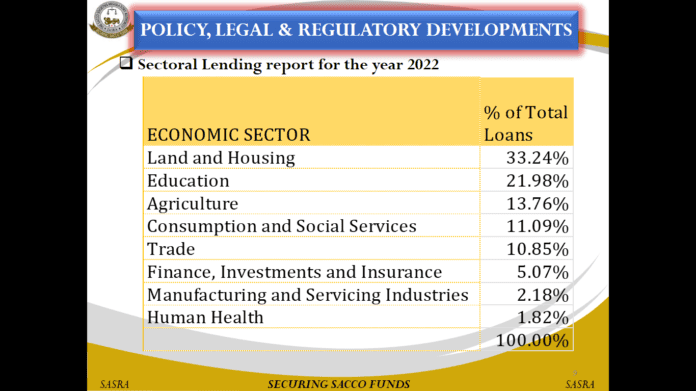The latest figures from the Sacco Societies Regulatory Authority (SASRA) database indicate that the Land and Housing sector received the largest lending from Savings and Credit Co-operative Societies (SACCOs) in 2022, at 33.24% of total loans.
This signifies a sharp growth in loans spent on land and housing in 2022 compared to 26.9% in 2021, highlighting the cooperative movement’s role in enabling affordable homeownership countrywide.
The latest percentage means Saccos disbursed over Ksh227 billion to support members to own land and build decent homes last year.
The sub-sector gross loans stood at Ksh 680.35 billion, comprising Ksh 586.16 billion disbursed through Deposit Taking (DT) -Saccos and Ksh 94.16 billion taken out by members of Non-Withdrawable Deposit Taking (NWDT)-Saccos. The growth rate increased in the aggregate for DT-Saccos from 9.67% to 11.76%, according to SASRA’s recent Sacco Sub-Sector Financial Status report.
Affordable housing has been a cornerstone of the government’s agenda, with the new Financial Bill making it mandatory for Kenyans to contribute 1.5% of their salaries tax towards financing the construction of houses in counties. However, to succeed, collaborative efforts between government, communities and the private sector are required, which necessarily demands a new conversation that brings the intended beneficiaries into the board room.
The co-operative movement, one of Kenya’s oldest but most enduring business forms, plays a big role in enabling homeownership. As community-entrenched businesses, co-operatives are catalysts that can revolutionize the housing sector through community-oriented, market-based solutions. Co-operatives help members achieve greater prosperity directly—through access to credit and higher earnings—and indirectly by facilitating financial education, mentorship, and training.
Various studies show members attest that their co-operatives help them make better decisions at home and in their businesses. A World Bank report last year noted that co-operatives provide 80% of housing needs in the country, making owning a house cheaper for the middle and low-income class.
Over ten Saccos are currently partnering with Kenya Mortgage Refinance Company (KMRC), helping fulfill members’ dreams of having decent homes, which previously were out of their reach thanks to expensive mortgage facilities that locked out many.
Cooperative development strategies dovetail with government development plans and have already proven to be powerful allies in driving equitable growth and reducing poverty. This is why Kenya needs a Cooperative model to achieve affordable housing. Homeownership promotes economic equality. It has been argued that homeowners, on average, earn higher incomes and have higher savings than renters.
The SASRA sectoral report further buttresses the social and economic importance of being a member of a co-operative society. Access to affordable loans is a key plus, especially for Sacco members, with SASRA noting that besides offering land and housing loans, Saccos also financed other sectors.
The data indicates 21.98% of the subsector’s gross loans financed education, 13.76% for Agriculture, 11.09% for Consumption and Social Services, 10.85% for Trade, 5.07% for Finance, Investment and Insurance, 2.18% for Manufacturing and Services Industry, and 1.82% Human Health.
Several Saccos are aligning their lending model to the government’s priority economic areas.
According to data from Sacco Societies Regulatory Authority (SASRA), DT-Saccos remain the largest and most dominant segment of the Sacco industry while the NWDT-Saccos follow at a distant second.
However, despite their small size, NWDT-Saccos continue to play a critical role in the financial inclusion arena and cannot be ignored.
Whereas DT-Saccos command the largest market share segment due to their sizes, most of these DT-Saccos are still in the small-tiered category with assets below Ksh1 billion.
The Balance Sheet size of the Sacco sub-sector stood at Ksh 890.3 billion as of December 31st 2022, with DT Saccos having the largest share of Ksh 763.5 billion, while non-withdrawable deposit-taking Sacco had an asset size worth Ksh126.8 billion, the sub-sector recording an aggregate growth in total assets of 10.31%.
DT Saccos recorded a growth in total assets of 10.48% from Ksh 10.10%, according to figures presented during the Sacco Sub-sector Report to the Regulatory Policy Roundtable, held in Naivasha recently.
Total members’ deposits held by the sub-sector stood at Ksh 620.45 billion, made up of Ksh 522.59 billion accumulated by DT-Saccos and NWDT-Saccos, having a total of Ksh94.19 billion. Again, there was a marginal aggregate growth rate from 9.80% to 9.84% for both DT-Saccos.
Although the provisions of Section 29 of the Co-operative Societies Act, CAP 490 provides for the manner in which any two or more co-operative societies may, by a special resolution, resolve to form a single Society, regulated Sacco Societies have not embraced amalgamations even when their going concern as a business is threatened due to harsh operating environment and severe losses leading to non-compliance with key prudential requirements, according to SASRA.
“Legal amendments to allow Saccos to have shared services, as well as the establishment of a Central Liquidity Facility, is still being processed by the Ministry of Co-operatives and MSMEs Development before it can be presented to the Cabinet for approval,” said Peter Njuguna, SASRA Chief Executive Officer.
He told the Roundtable that the primary purpose of these amendments is to address an efficiency problem and ensure financial stability and inclusion in the Sacco industry. The proposed regulations also seek to provide a legal framework for licensing and supervision of Sacco Shared Services Entities in Kenya.
The inaugural Annual General Meeting of the Kenya Saccos Central Liquidity and Shared Services Co-operative Society Limited (Sacco-Central) was held on April 15th 2023, in Nairobi. Membership of the Sacco Central is open to all Saccos willing to join the platform.
“The technology to drive this platform is set to be acquired beginning the 2023/24 financial year,” said Mr Njuguna.
He cited the inability of several DT-Saccos to cope with various business-related as well as challenges that prevent them from meeting the Capital Adequacy Requirements set out by SASRA.
“The Authority has engaged a consultant to collate and collect comments on the pain points with attaining capital adequacy requirements. Once completed, the findings of this report will be sent out to all DT Saccos,” he said.





